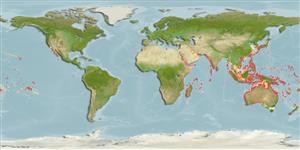Common names from other countries
Environment: milieu / climate zone / depth range / distribution range
Écologie
Récifal; profondeur 0 - 40 m (Ref. 848), usually 12 - 15 m (Ref. 98471). Tropical; 54°N - 44°S, 25°E - 110°W (Ref. 848)
Distribution
Pays | Zones FAO | Écosystèmes | Occurrences | Introductions
Indo-Pacific: Japan to Australia and South Africa to Easter Island.
Length at first maturity / Taille / Poids / Âge
Maturity: Lm ? range ? - ? cm
Description synthétique
Morphologie
Oval walls of the corallites are closely set, slightly plocoid, and variable in details of septa and costae. Either bright green or brown, with a lighter oral disc.
In most reef environments, including shaded environments such as under overhangs. Subtidal. Also occurs in rocky foreshores protected from strong wave exposure, on the back and foreslope of reef, in lagoons and outer reef channel (Ref. 98471). Polyps extend during daytime (Ref. 130769).
Life cycle and mating behavior
Maturité | Reproduction | Frai | Œufs | Fécondité | Larves
Members of the class Anthozoa are either gonochoric or hermaphroditic. Mature gametes are shed into the coelenteron and spawned through the mouth. Life cycle: The zygote develops into a planktonic planula larva. Metamorphosis begins with early morphogenesis of tentacles, septa and pharynx before larval settlement on the aboral end.
Veron, J.E.N. and G. Hodgson. 1989. (Ref. 8817)
Statut dans la liste rouge de l'IUCN (Ref. 130435)
statut CITES (Ref. 108899)
Not Evaluated
Utilisations par l'homme
| FishSource |
Outils
Plus d'informations
Taille/ÂgeCroissanceLongueur-poidsLongueur-longueurMorphologieLarvesAbondance
Sources Internet
Estimates based on models
Preferred temperature
(Ref.
115969): 21.8 - 29.2, mean 28 (based on 3278 cells).
Catégorie de prix
Unknown.
